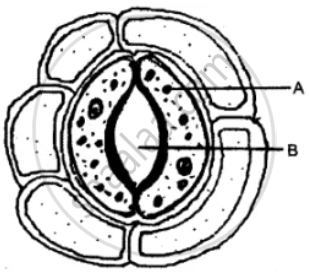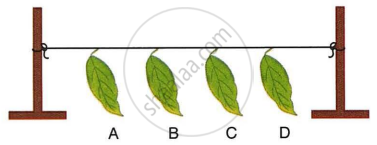Advertisements
Advertisements
प्रश्न
Give Reasons for the following:
Guard cells are small in size and are kidney-shaped in outline.
उत्तर
Because of their small size, guard cells are rapidly influenced by turgor changes. Because of their kidney-shaped outline, they remain joined at their ends. This concave-convex curvature of the two guard cells can be varied easily and this further facilitates the stomatal pore to open and close easily.
APPEARS IN
संबंधित प्रश्न
Distinguish between the following:
Stomata and lenticels
Given ahead is a diagram of an experimental setup to study the process of transpiration in plants. Study the same and then answer the question that follows:

- Name the colour of dry cobalt chloride paper.
- Is the experimental leaf a monocot or a dicot? Give a reason to support your answer.
- Why are glass slides placed over the dry cobalt chloride papers?
- After about half an hour, what change, if any, would you expect to find in the cobalt chloride paper placed on the dorsal and ventral sides of the leaf? Give a reason to support your answer.
The diagram below represents a structure found in a leaf.

Study the same and answer the questions that follow:
(i) Name the pis labeled A and B.
(ii) What is the biological term for the above structure?
(iii) What is the function of the part labeled A?
(iv) Mention two structural features of A, which help in the function mentioned in (iii) above.
(v) Where is this structure likely to be found in a leaf?
(vi) The above structure helps in the process of transpiration. Explain the term transpiration.
(vii) How many other cells are found surrounding this structure as seen in the diagram?
State the Location:
Stomata
Write the functional activity of the following structure:
Stomata
Mark the most appropriate answer in the following:
In the mechanism of opening and closing of stomata, the important factor is
When guard cells are flaccid, the stoma must be ______.
Define the following term:
Cuticle
The given figure represents an experiment:

- Leaf A was coated with grease on both surfaces.
- Leaf B was coated with grease on the lower surface.
- Leaf C was coated with grease on the upper surface.
- Leaf D was left without any application of grease. All four leaves A, B, C and D were left in a room for about 24 hours.
- Which leaf dries first? Give reason.
- Which leaf dries last? Give reason.
